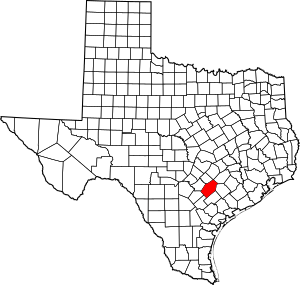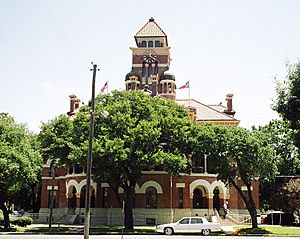Gonzales County, Texas facts for kids
Quick facts for kids
Gonzales County
|
|
|---|---|

Location within the U.S. state of Texas
|
|
 Texas's location within the U.S. |
|
| Country | |
| State | |
| Founded | 1837 |
| Named for | City of Gonzales |
| Seat | Gonzales |
| Largest city | Gonzales |
| Area | |
| • Total | 1,070 sq mi (2,800 km2) |
| • Land | 1,067 sq mi (2,760 km2) |
| • Water | 3.2 sq mi (8 km2) 0.3% |
| Population
(2020)
|
|
| • Total | 19,653 |
| • Density | 18.37/sq mi (7.09/km2) |
| Time zone | UTC−6 (Central) |
| • Summer (DST) | UTC−5 (CDT) |
| Congressional district | 27th |

Gonzales County is a county in the state of Texas. It is close to the big cities of Austin and San Antonio. In 2020, about 19,653 people lived here.
The county is named after its main city, Gonzales. Gonzales County was created in 1836 and officially started in 1837. The county government is proud to say it has no debt. This means it manages its money very carefully.
Contents
History of Gonzales County
Gonzales County has a long and interesting history. People have lived here for thousands of years.
Early Inhabitants and European Arrival
Long ago, Paleo-Indians lived here as Hunter-gatherers. Later, groups like the Coahuiltecan, Tonkawa, and Karankawa tribes moved into the area. Sadly, many of them became sick from new diseases brought by European explorers.
In the 1800s, the Comanche and Waco tribes also lived in the area. They often had conflicts with the new settlers from Europe and America.
Texas Under Different Flags
- 1519–1685: Hernando Cortez and Alonso Álvarez de Pineda claimed Texas for Spain.
- 1685–1690: France briefly had a presence in Texas.
- 1821: Mexico won its freedom from Spain. People from the United States began to move to Texas and became Mexican citizens.
The Founding of Gonzales
- 1825: Green DeWitt received permission from the Mexican government to start a colony in Texas. The city of Gonzales was founded. It was named after Rafael Gonzales, who was the governor of the area.
- 1828: A visitor named Jean Louis Berlandier found farms, homes, and a fort in Gonzales. He also saw nearby villages of the Tonkawa and Karankawa people.
- 1831: The government sent a cannon to Gonzales. This cannon was meant to help settlers protect themselves from Native American raids.
The Texas Revolution Begins
- 1835: Settlers in Texas had disagreements with Mexico. They sent delegates to meetings to talk about these issues.
- September 1835: The Mexican government saw these meetings as a rebellion. They sent soldiers to Gonzales to take back the cannon.
- October 2, 1835: The Battle of Gonzales happened. This was the first fight of the Texas Revolution. The colonists refused to give up the cannon. They put a flag above it that said, "Come and take it". This event is celebrated every year at the "Come and Take It Festival".
- October 13 – December 9, 1835: The Siege of Bexar was the first major battle of the Texas Revolution.
Gonzales County in the Revolution
- 1836: Gonzales County was officially created.
- February 23-24, 1836: Messages from William B. Travis at the Alamo reached Gonzales. He asked for help and supplies.
- February 27, 1836: The Gonzales Alamo Relief Force of 32 men, led by Lieutenant George C. Kimble, left to help the fighters at the Alamo.
- March 1, 1836: These 32 brave men, known as the "Immortal 32," made it inside the Alamo.
- March 2, 1836: The Texas Declaration of Independence was signed. This created the Republic of Texas.
- March 6, 1836: The Alamo fell.
- March 13–14, 1836: Susanna Dickinson, a survivor from the Alamo, arrived in Gonzales. When Sam Houston heard the news, he ordered Gonzales to be burned to the ground. He set up his headquarters under a large oak tree.
Later History
- 1838: Men from Gonzales helped found the town of Walnut Springs, which is now Seguin.
- 1840: Gonzales men fought in the Battle of Plum Creek against the Comanches.
- 1850: Gonzales College was started. It was the first school in Texas to give college degrees to women.
- 1853: The local newspaper, The Gonzales Inquirer, began publishing.
- 1860: The county's population was 8,059 people.
- 1861: Gonzales County voted to leave the Union. Texas joined the Confederate States of America.
- 1870: Texas was readmitted to the United States.
- Late 1800s: Railroads like the Galveston, Harrisburg and San Antonio Railway came through the county.
- 1894: John Wesley Hardin, a famous outlaw, returned to Gonzales. He became a lawyer there.
- 1898: Twenty-three men from the county served in the Spanish–American War.
- World War I: 1,106 men from Gonzales County served in the war.
- 1935: A monument was dedicated in Cost. It honors the first shot of the Texas Revolution.
- 1936: Palmetto State Park opened to the public.
- 1939: The Gonzales Warm Springs Foundation opened to treat polio.
- World War II: About 3,000 men from Gonzales County served in this war.
Geography of Gonzales County
Gonzales County covers about 1,070 square miles. Most of this area is land, with only a small part being water.
The county is directly connected to major highways. These roads see a lot of traffic because Gonzales County is close to Austin and San Antonio.
River Crossings
Gonzales County has bridges over the Guadalupe River and the San Marcos River.
- North FM 466 / SH 80 bridge near Belmont.
- North FM 466 / County Road 143 bridge near Monthalia.
- North SH 97 / US 183 bridge in the City of Gonzales, Texas.
- East US 90A / FM 2091 bridge over the San Marcos River near Ottine.
Major Highways
- I-10 / US 90 connects San Antonio and Houston. It passes through Belmont, Ottine, and Waelder.
- US 183 / SH 80 goes from Gonzales to Austin, and through Belmont, Leesville, and Nixon.
 U.S. Highway 87 runs through Nixon and Smiley.
U.S. Highway 87 runs through Nixon and Smiley. State Highway 97 connects Waelder, the City of Gonzales, Bebe, and Leesville.
State Highway 97 connects Waelder, the City of Gonzales, Bebe, and Leesville. State Highway 304 goes from Gonzales to Bastrop.
State Highway 304 goes from Gonzales to Bastrop.
 U.S. Highway 90 Alternate connects Belmont and the City of Gonzales.
U.S. Highway 90 Alternate connects Belmont and the City of Gonzales.
Adjacent Counties
Gonzales County shares borders with these counties:
- Caldwell County (north)
- Fayette County (northeast)
- Lavaca County (east)
- Dewitt County (south)
- Karnes County (southwest)
- Wilson County (west)
- Guadalupe County (northwest)
Population and People
| Historical population | |||
|---|---|---|---|
| Census | Pop. | %± | |
| 1850 | 1,492 | — | |
| 1860 | 8,059 | 440.1% | |
| 1870 | 8,951 | 11.1% | |
| 1880 | 14,840 | 65.8% | |
| 1890 | 18,016 | 21.4% | |
| 1900 | 28,882 | 60.3% | |
| 1910 | 28,055 | −2.9% | |
| 1920 | 28,438 | 1.4% | |
| 1930 | 28,337 | −0.4% | |
| 1940 | 26,075 | −8.0% | |
| 1950 | 21,164 | −18.8% | |
| 1960 | 17,845 | −15.7% | |
| 1970 | 16,375 | −8.2% | |
| 1980 | 16,883 | 3.1% | |
| 1990 | 17,205 | 1.9% | |
| 2000 | 18,628 | 8.3% | |
| 2010 | 19,807 | 6.3% | |
| 2020 | 19,653 | −0.8% | |
| U.S. Decennial Census 1850–2010 2010 2020 |
|||
In 2020, Gonzales County had a population of 19,653 people. The population density was about 17 people per square mile.
In 2000, about 34% of households had children under 18. The average household had about 2.69 people. The median age in the county was 36 years old. This means half the people were younger than 36, and half were older.
The median income for a household in 2000 was $28,368. This means half the households earned more than this, and half earned less. About 18.6% of the population lived below the poverty line.
Communities in Gonzales County
Gonzales County has several cities and smaller communities.
Cities
- Gonzales (This is the main city and county seat)
- Nixon (A small part of Nixon is in Wilson County)
- Smiley
- Waelder
Unincorporated Areas
These are smaller communities that are not officially cities.
Ghost Towns
These are places that used to be towns but are now mostly empty.
Education in Gonzales County
Several school districts serve the students in Gonzales County:
- Cuero Independent School District
- Gonzales Independent School District
- Moulton Independent School District
- Nixon-Smiley Consolidated Independent School District
- Shiner Independent School District
- Waelder Independent School District
- Yoakum Independent School District
All areas of the county are also served by Victoria College, which offers higher education.
See also
 In Spanish: Condado de Gonzales para niños
In Spanish: Condado de Gonzales para niños

